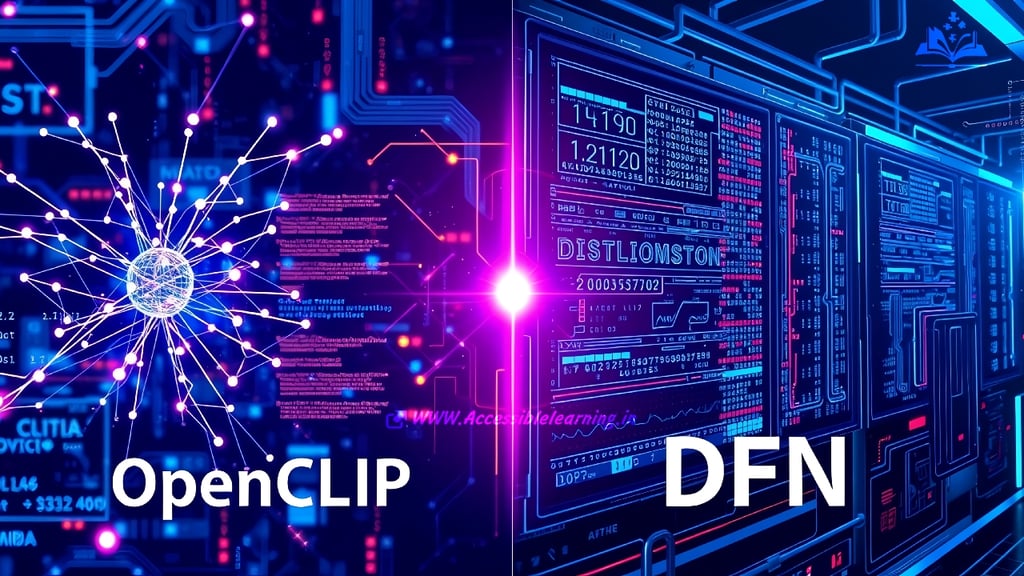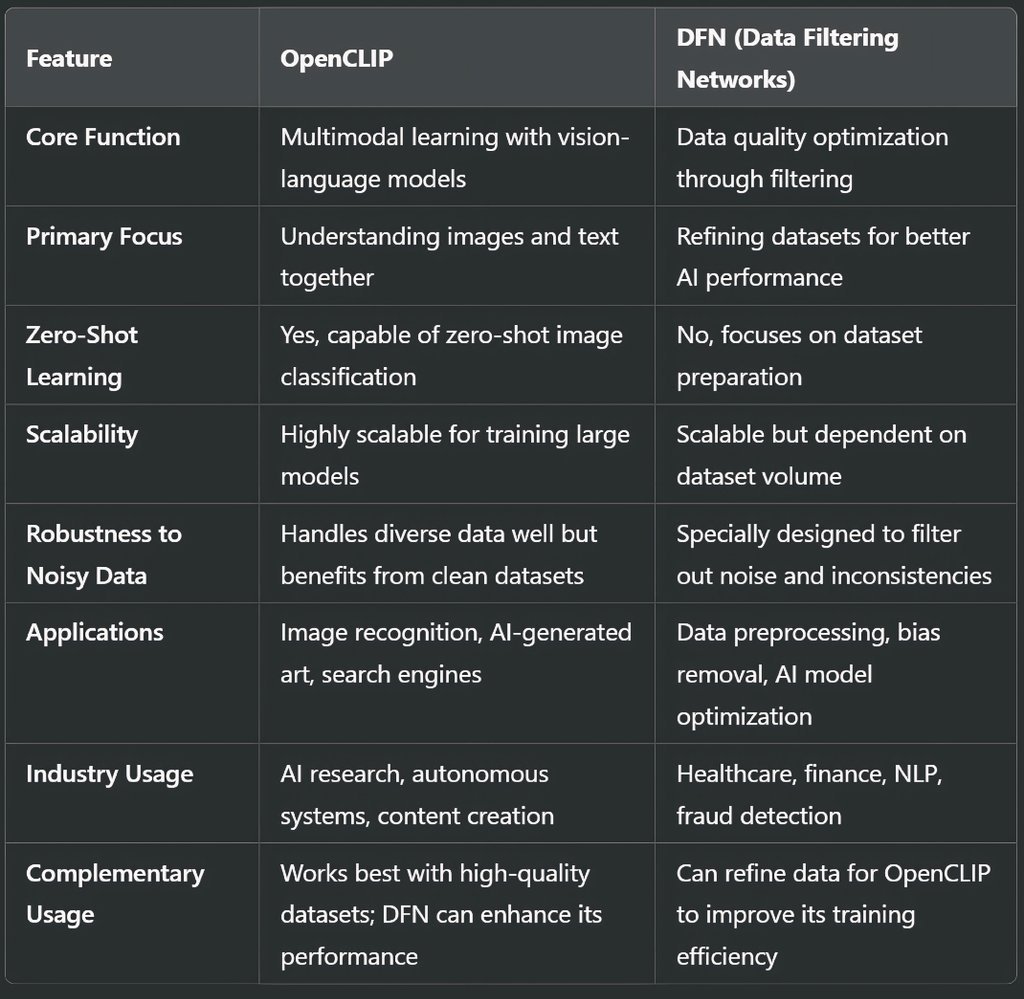
Comparing OpenCLIP and DFN: Key Differences and Use Cases Explained
Explore a comprehensive comparison between OpenCLIP and DFN (Data Filtering Networks). Learn about their key features, applications, differences, and how they contribute to AI advancements. Discover which one suits your needs best and how they can work together for optimal performance.
COMPANY/INDUSTRYAI/FUTUREEDITOR/TOOLS
Sachin K Chaurasiya
3/15/20254 min read


In the fast-evolving landscape of artificial intelligence, foundation models play a crucial role in shaping the way machines understand and process information. Two significant technologies making waves in this field are OpenCLIP (Open Contrastive Language-Image Pretraining) and DFN (Data Filtering Networks). While OpenCLIP enhances multimodal learning by improving vision-language model training, DFN focuses on refining dataset quality by filtering noisy or irrelevant data. Understanding their capabilities, applications, and differences can help AI researchers, developers, and businesses make informed decisions.
What is OpenCLIP?
OpenCLIP is an open-source implementation of CLIP (Contrastive Language-Image Pretraining), developed to enable training of vision-language models in a scalable and transparent manner. Originally introduced by OpenAI, CLIP models learn from vast amounts of image-text pairs, allowing them to perform zero-shot learning, where they can recognize unseen concepts without additional fine-tuning.
Key Features
Multimodal Learning: Trains AI to understand both images and text, making it highly useful in applications like image captioning, visual search, and AI-generated art.
Zero-Shot Learning: Unlike traditional models requiring labeled data, OpenCLIP can classify and describe images using natural language queries without needing retraining.
Scalability: Designed to be open-source, allowing researchers to train, modify, and fine-tune models on custom datasets.
Cross-Domain Generalization: Performs well across various tasks without specific fine-tuning, making it versatile in handling multiple applications.
Enhanced Training Efficiency: Utilizes contrastive learning to align visual and textual representations efficiently.
Robustness to Noisy Data: Can handle large-scale datasets with diverse and unfiltered data, making it effective even in real-world noisy environments.
Applications
AI-Powered Search Engines: Used by platforms like Google and Bing for improved image and text retrieval.
Autonomous Vehicles: Helps self-driving cars understand visual and textual inputs from road signs and navigation systems.
Content Moderation: Assists in identifying inappropriate or misleading images based on textual descriptions.
Creative AI: Used in tools like DALLE and Stable Diffusion to generate high-quality AI art.
Medical Image Analysis: Helps in diagnosing diseases by analyzing medical images and correlating them with textual data.
E-commerce and Retail: Enhances product discovery by enabling image-to-text search capabilities.
Use Cases
AI-Powered Search Engines
Enhances image-to-text retrieval for search engines like Google and Bing.
It helps in finding relevant images from large datasets based on textual queries.
Content Moderation & Compliance
Detects inappropriate or misleading images using textual descriptions.
Assists social media platforms in filtering harmful content.
AI-Generated Art & Creativity
Powers tools like DALLE and Stable Diffusion for AI-based image generation.
Enables text-to-image and image-to-text synthesis for digital artists.
E-commerce & Retail
Enables visual search, allowing users to find products by uploading images.
Enhances personalized recommendations based on image-text understanding.
Medical Imaging & Diagnosis
Helps in disease detection by correlating medical images with text-based reports.
Assists radiologists by improving pattern recognition in medical scans.
Autonomous Vehicles & Robotics
Improves object detection by analyzing both textual commands and visual input.
Enhances self-driving car systems by recognizing road signs and surroundings.


What is DFN (Data Filtering Networks)?
DFN, or Data Filtering Networks, is a framework designed to improve data quality by automatically filtering out noisy, biased, or irrelevant samples in large datasets. In AI, data quality is just as important as model architecture, and DFN plays a key role in optimizing dataset integrity for superior model performance.
Key Features
Data Cleaning & Filtering: Removes incorrect, duplicate, or low-quality data to ensure cleaner and more efficient datasets.
Bias Reduction: Identifies and mitigates biases in datasets, leading to fairer AI predictions.
Adaptive Filtering: Uses deep learning techniques to adaptively refine datasets based on the model’s needs.
Performance Optimization: Enhances AI model accuracy by removing misleading training examples.
Dynamic Learning Adaptation: Continuously improves data filtering strategies based on the evolving nature of the dataset.
Integration with Pretraining Pipelines: Works well with models like OpenCLIP to refine the input data before training, ensuring higher-quality outputs.
Applications
Natural Language Processing (NLP): Helps clean noisy text data to improve chatbot and language model performance.
Computer Vision: Enhances image datasets by removing blurry, irrelevant, or misclassified images.
Healthcare AI: Filters medical datasets to ensure accurate and bias-free disease diagnosis models.
Fraud Detection: Cleans financial datasets for more accurate anomaly detection and fraud prevention.
Autonomous Systems: Ensures self-driving AI models train on high-quality, accurate visual datasets to improve road safety.
Cybersecurity: Filters cybersecurity datasets to enhance AI-driven threat detection.
Use Cases
Data Cleaning & Preprocessing for AI Models
Filters noisy, redundant, or biased data before AI training.
Ensures high-quality datasets, improving model accuracy and efficiency.
Bias Reduction in AI Training
Detects and removes biased samples, ensuring fair AI decisions.
Reduces algorithmic discrimination in NLP and computer vision applications.
Fraud Detection & Cybersecurity
Cleans financial datasets to improve fraud detection models.
Enhances cybersecurity AI by filtering noisy or misleading threat data.
NLP & Chatbot Optimization
Filters low-quality text data to enhance chatbot responses and language models.
Improves sentiment analysis by removing irrelevant or incorrect training samples.
Healthcare & Medical Research
Ensures that AI-based medical models are trained on high-quality, unbiased datasets.
Improves disease prediction by filtering misleading patient records.
Computer Vision & Image Processing
Refines datasets for image classification and object detection tasks.
Removes blurry, mislabeled, or low-resolution images to improve AI accuracy.


Which One Should You Choose?
If you need an AI model capable of understanding both images and text, OpenCLIP is the better choice.
If your priority is cleaning and optimizing datasets for improved AI performance, DFN is the ideal tool.
If you work with multimodal AI and want the best results, using both OpenCLIP and DFN together can lead to higher-quality model training and improved generalization.
DFN can be a preprocessing step for OpenCLIP, ensuring that the dataset used for contrastive learning is of high quality and free from biases or redundancies.
Both OpenCLIP and DFN contribute to the evolution of AI in unique ways. OpenCLIP enables machines to learn from multimodal data, expanding their ability to understand images and text without explicit training. Meanwhile, DFN ensures high-quality, bias-free datasets, making AI models more accurate and reliable. Depending on your goals, either or both can be powerful assets in developing cutting-edge AI solutions.
As AI continues to advance, integrating these technologies can pave the way for more intelligent, ethical, and efficient AI systems. Whether you’re building a next-generation chatbot, a robust fraud detection model, or an advanced AI-powered search engine, understanding the strengths of OpenCLIP and DFN will be crucial in making the right technological choices. By leveraging both, developers can enhance AI accuracy, fairness, and robustness, ensuring better outcomes across various industries.
Subscribe To Our Newsletter
All © Copyright reserved by Accessible-Learning Hub
| Terms & Conditions
Knowledge is power. Learn with Us. 📚


